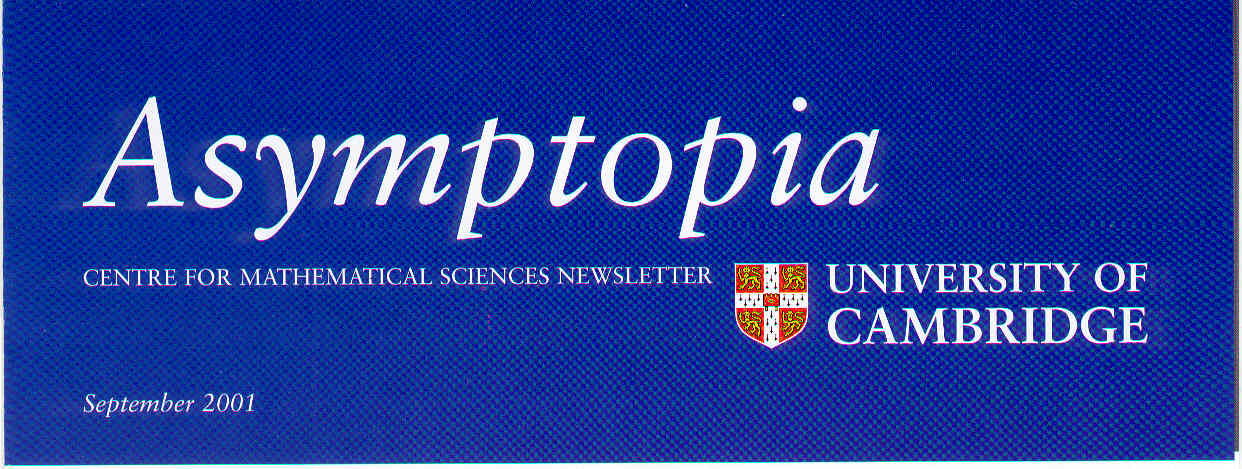
|
Progress
Books are being delivered to the Betty and Gordon Moore Library, which will open its doors on 1 October. The Faulkes Gatehouse is now the entrance to the site for pedestrians and cyclists. It is between the Library and the Newton Institute, for which it provides valuable additional offices and a seminar room. Pavilion E, the Faulkes Institute for Geometry, will be ready soon. G and H will house the Corfield Institute for Applied Mathematics by the autumn of next year, and pavilion F will complete the development shortly afterwards.
 |
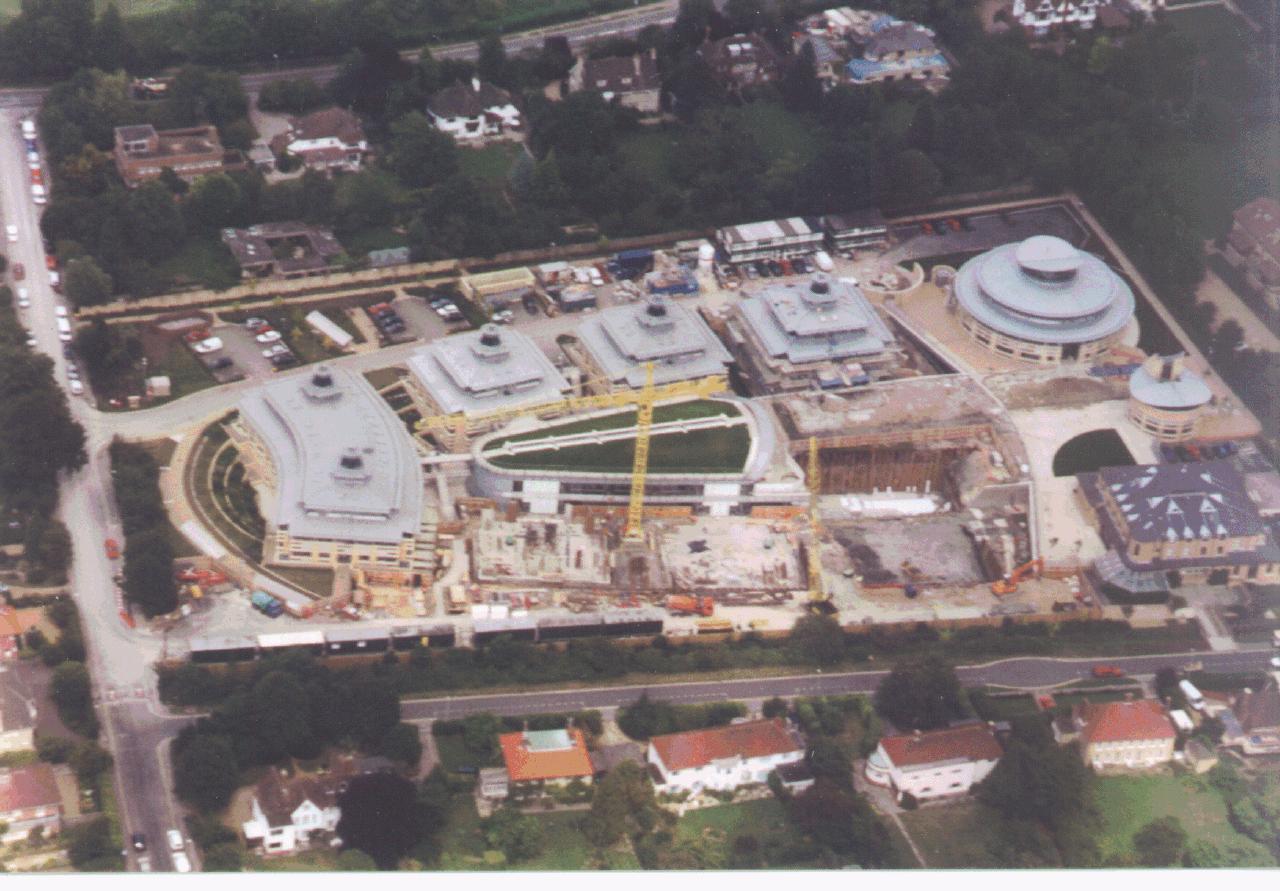 |
|
|
|

The Future
So by the start of 2003 all of us will be on our splendid new site. The extra space will allow the creation of a number of new research groups, and we are starting to raise funds for these. The first will be devoted to quantum information theory. It will be led by a professor funded initially by the Cambridge-MIT Institute, which was set up by the government to encourage competitiveness and scientific excellence. The professorship will be continued in perpetuity by a generous endowment promised by the widow of one of our alumni and will be named after him.
| Postmodern Theoretical Physics Professor Michael Green, DAMTP |
Just over a year ago the DAMTP High Energy Physics and General Relativity Groups decamped from Silver Street to become the first occupants of the Wilberforce Road site, housed in the Rausing building. Both of these groups are large and exceptionally distinguished, with a total of over twenty permanent and long-term faculty, of whom seven are Fellows of the Royal Society. As the initial hardships of working on a building site were overcome it became apparent that the new environment would not only provide greatly improved working conditions, but that the relocation gave the opportunity for bridging the historical separation between the two groups.
The existence of separate research groups in general relativity and in elementary particle physics dates back to a time when research in general relativity, which is Einstein's theory of gravity, had little in common with the study of elementary particles. These subatomic particles - the electron, the quarks and various others - and the forces they exert are described within the framework of quantum theory. A beautiful theoretical description of three of the forces, the strong, weak and electromagnetic forces, had developed by the early 1970's. However, the general relativity appears to be incompatible with quantum theory. This incompatibility between the two main pillars of twentieth century physics has been a long-standing puzzle since the original formulation of quantum mechanics in 1925.
In the mid-1970's this unsatisfactory situation began to change, in part due to Stephen Hawking's work on the quantum properties of black holes. This illustrated some of the remarkable features that might be expected when the laws of quantum mechanics are combined with the force of gravity. Quite independently, the situation was radically altered by the development of string theory which has at last provided a framework for a consistent quantum theory of all the forces, including gravity. Members of the DAMTP groups have played leading roles at every stage in these developments.
String theory originated in the early 1970's, when it was developed for a more restricted purpose. One of its most attractive features is the utter simplicity of its basic premise. Whereas all previous theories of elementary particles assume that particles are points, string theory assumes that they are extended, string-like, objects. This simple starting point leads to a rich physical and mathematical structure. For example, it turns out that quantum strings automatically lead to the force of gravity as described by Einstein's equations - general relativity emerges as a consequence of the theory instead of being an assumption! The realisation in 1984 that a version of the theory known as superstring theory not only contains gravity along with other forces, but also appears to be consistent with quantum theory, led to a rapid explosion of interest. This interest has increased further over the years as remarkable properties of the theory have been unravelled and its scope has increased. Indeed, string theory has now encompassed other approaches to describing gravity and the whole is sometimes known as 'M-theory'.
 |
An illustration of the surface swept out by strings (represented by the loops) as they move through space-time and interact with each other. The properties of string theory are closely related to the mathematics of such 'Riemann surfaces' immersed in space-time. |
Despite these many insights the theory is still only understood at a superficial level and many challenges remain. The greatest of these is to understand how string theory leads to a quantum description of space-time. It has long been realised that any quantum theory of gravity will necessarily require a novel form of geometry, loosely termed 'quantum geometry', that replaces the kinds of geometric ideas involved in general relativity. Although this has still to be properly formulated, there are many indications within string theory of how it may arise. This is just one example of the strong links that have evolved over the past fifteen years between this area of theoretical physics and a wide range of mathematics. Even if there are not yet any testable experimental predictions, these connections between string theory and mathematics have more than justified its existence.
Research in this area involves a subtle combination of sophisticated mathematics, physical ideas and a strong belief that a theory that is so elegant must be trying to tell us something about the physical world. Not only does the Rausing building house a wealth of talented theoretical physicists in the GR and HEP groups but the concentration of pure mathematicians on the CMS site gives the opportunity for a fruitful interchange of ideas between the far-flung intellectual disciplines encompassed by string theory. The proximity of the Newton Institute further enhances the complex. A six-month Newton Institute programme in M-theory in 2002 will bring to Cambridge most of the leading researchers in this area and will culminate in July with the main annual international conference - Strings2002 - that will be hosted by DAMTP.
| Maths Counts Professor Keith Moffatt, Isaac Newton Institute for Mathematical Sciences |
Tube travellers may have noticed some of the striking mathematical posters that were designed at the Newton Institute for display month-by-month during World Mathematical Year 2000 in trains of the London Underground. Actually, the chance of spotting one in a single tube journey was about one in a hundred, so if you did see one, you could truly say "This was my lucky day".
The posters were designed to provide a glimpse of a wide range of applications of mathematics in such fields as pattern formation, hurricane dynamics, solar physics, network theory, coding theory, molecular biology, wave mechanics, and so on. The final poster of the series "Maths is For Ever", displayed during December 2000, was on numerology: it invited viewers to calculate just how many presents in total "my true love sent to me" over the twelve days of Christmas. A variety of answers were received at the Newton Institute, correct answers qualifying for a Fermat's Last Theorem T-Shirt. The posters can be seen together with some explanatory notes (more still to be written!) on the Newton Institute website www.newton.cam.ac.uk. This attracted wide interest, and many requests from schools for copies of the posters; so much so indeed that EPSRC, who funded the project, has now undertaken to print an additional 6000 sets of the posters for distribution to all UK schools teaching maths up to A-Level. Many sets have also been distributed in the Far East by World Scientific who undertook a printing of 1000 sets free of charge.
Viewers of the TV soap Dawson's Creek (and there are some five million of these in USA and UK) may have noticed the posters which were used as backdrop in the classroom scenes of one or two of the episodes during April/May this year! In March 2001 the posters won a Merit level Heist award for excellence in an educational marketing campaign. The awards are issued annually to institutions from all over the UK in both further and higher education institutions.
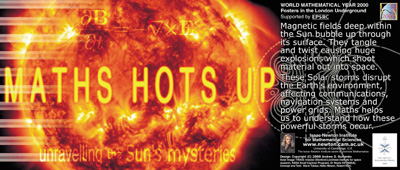
The two posters reproduced here are typical of the style that we adopted: each poster has a snappy title, sometimes a double entendre: Maths counts, maths stirs, maths is cool, maths hots up, maths is vital, maths makes waves, ... Fortunately, the year had only 12 months! Each poster has a colourful image, and some carefully worded text to be comprehended between two tube stations - no more! Finally, each poster incorporates a hint of the serious mathematics that lurks beneath the surface, e.g. the Korteweg-de Vries equation can be spotted by an eagle eye on the Maths Makes Waves poster.
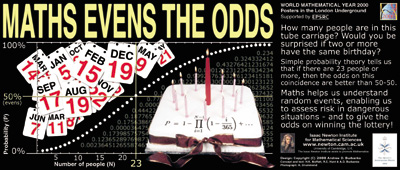
The individual posters acknowledge the support of EPSRC, and the input of many colleagues from a number of Universities (Bristol, Bath, Exeter, Leeds, East Anglia as well as Cambridge), and from a number of other organisations (e.g. British Antarctic Survey). Particular thanks are due to Robert Hunt who participated in developing the various concepts, and to Andy Burbanks, whose eye for design and brilliant use of colour graphics was vital to the success of the project.
| Webby Award |
 |
We are delighted to announce that Plus (http://plus.maths.org/), the online magazine on mathematics and its applications produced by the Millennium Mathematics Project here in the Maths Faculty, has won this year's Webby Award in the Science category and is therefore officially the best Science site on the whole web. Robert Hunt is the Editor of Plus and so was in San Francisco to receive the trophy. The Plus team includes Mike Pearson, the web designer, assistant editors Mark Wainwright, Dr Helen Joyce and an enormously helpful technical team, particularly Rachel Thomas who has also contributed articles. |
| The Webbys are awarded by the International Academy of Digital Arts and Sciences, members of which include Francis Ford Coppola, David Bowie, Tina Brown, Matt Groening and scientists from a wide variety of institutions such as Berkeley, Stanford, MIT and Xerox. The Webbys have emerged (according to the BBC) as the world's most prestigious Internet award, with a glittering annual awards ceremony from which Robert has just returned. Plus beat off competition from sites on topics as diverse as oceanography and molecular biology, and became one of only two UK sites to be successful (the other being the BBC World Service's internet site). Other winners in different categories included CNN, National Geographic, Google, Microsoft, Yahoo, Expedia.com and Vint Cerf, so given our relative size we're overwhelmed to have won an award. |  |
| News in Brief |
| David Crighton Fund Patrick Hawke-Smith Cambridge University Development Office |
Many thanks are due to all those who have supported the David Crighton Fund, in memory of the former Head of the Department of Applied Mathematics and Theoretical Physics. The total pledged to it currently stands at œ174,835. The Fund will form a permanent memorial to Professor Crighton and a continuing source of assistance to young researchers working in his fields of interest.
Professor Tim Pedley, Chairman of the David Crighton Fund Committee, said, "David will be very greatly missed, both in Cambridge and among his friends and colleagues across the world. The response to the launch of this Fund has been tremendous and it will provide a fitting tribute to his life and work."
| Betty and Gordon Moore Library |
The Library will be part of the University Library, as well as being the departmental library for the two mathematics departments. It will cover the physical sciences, technology and mathematics and cost some 8 million pounds to build. Construction began in February 2000 and the Library will open in October 2001.
| Dill Faulkes Gatehouse |
| The Gatehouse, which is situated at the main pedestrian access to the site, is part of the Isaac Newton Institute for Mathematical Sciences. It has been built together with the Library and is funded by a donation of one million pounds from the Dill Faulkes Educational Trust. | 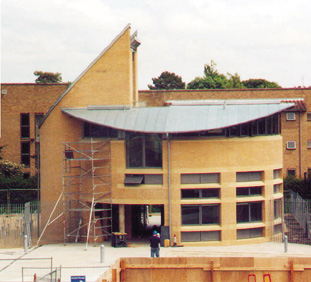 |
| Donations |
Those contemplating making a donation are invited to discuss it with Patrick Hawke-Smith of the University Development Office <ph250@cam.ac.uk>, or with Professor Peter Landshoff <P.V.Landshoff@damtp.cam.ac.uk>. Advice for American citizens on tax-efficient giving may be obtained from Cambridge in America <mail@cantab.org>.
